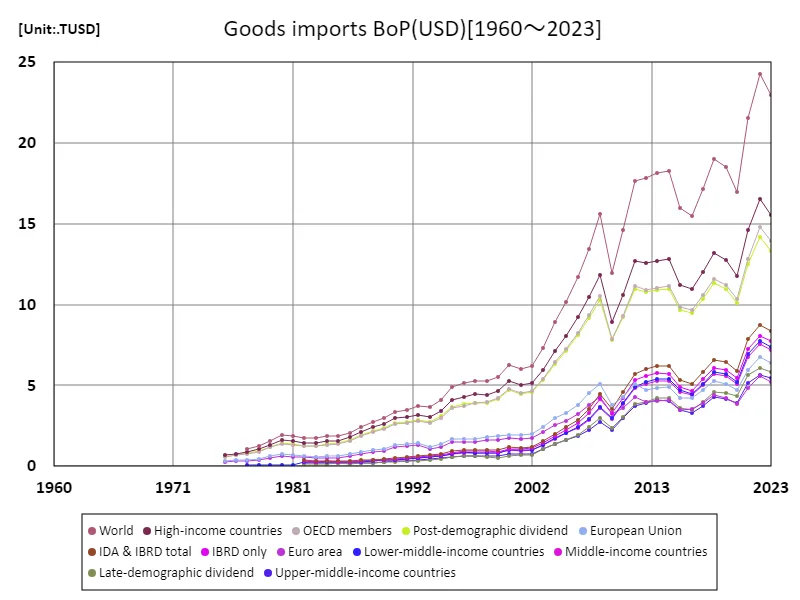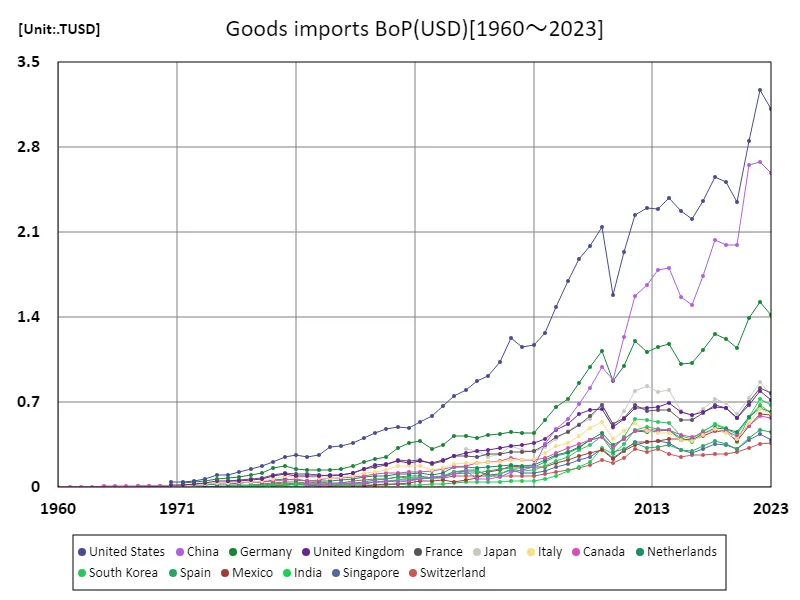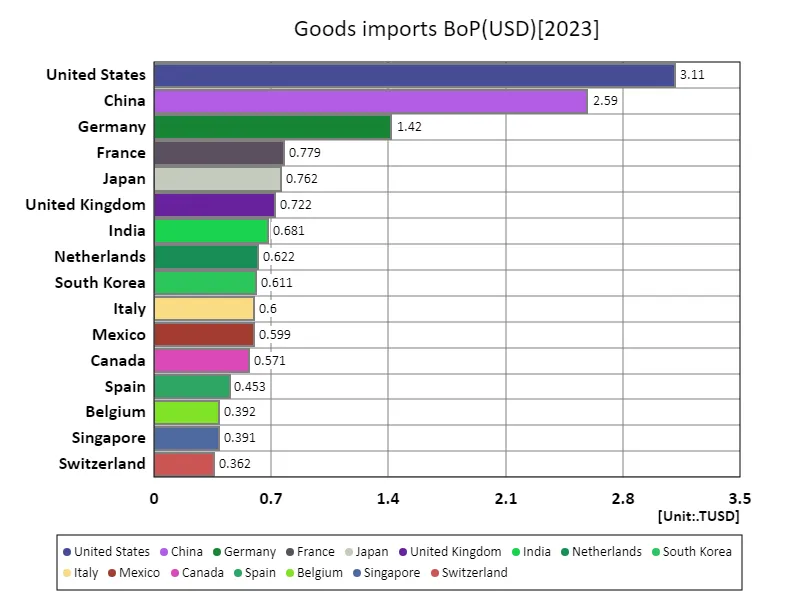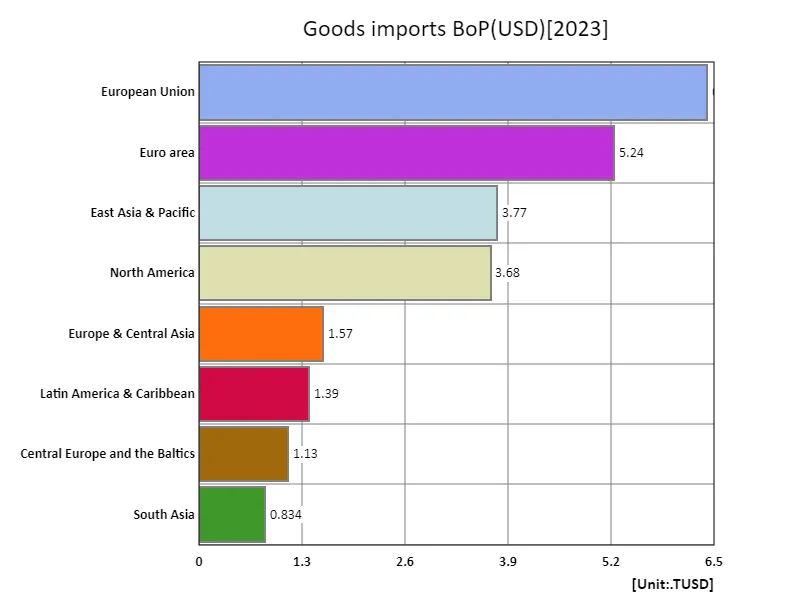Abstract
Data on ”exports of goods for sale (USD)” in trade exports is an important indicator of the international dynamics of economic activity. The evolution of global supply chains and economic recovery in each country are factors behind the world’s total exports reaching USD 23.9 trillion in 2023. Looking at data over the past decade, Asian markets in particular have grown rapidly, with China and India emerging as major export players. Digitalization and technological innovation are also making export operations more efficient and creating new market opportunities. On the other hand, geopolitical risks and trade wars are also having an impact, and these factors are intricately intertwined.
Goods Imported(usd)
Looking at data from 1960 to 2023, the value of merchandise imports of world sales has been steadily increasing. In particular, globalization has progressed since the 2000s, and trade volume has increased sharply. It will reach a peak of USD 24.3 trillion in 2022, but will decline to 94.5% of that in 2023. The decline is due to supply chain issues, geopolitical risks and economic uncertainty. In addition, other factors include the recovery phase from the COVID-19 pandemic and changes in economic policies in each country. Overall, the increase or decrease in import values is greatly influenced by fluctuations in the global economy, and future trends require careful analysis.


The maximum is 24.3TUSD[2022] of World, and the current value is about 94.5%
Product import (USD) (worldwide)
Analyzing data from 1960 to 2023, the value of U.S. merchandise imports has had a long-term upward trend. In particular, it peaked at 3.27 trillion USD in 2022, but fell to 95.1% of that amount in 2023. This growth is driven by the growing size and diversity of the American consumer market, as well as increasing globalization. The increase in imports, particularly from the 1990s to the early 2000s, was largely due to the outsourcing of manufacturing and the influx of consumer goods from overseas. The recent declines are likely due to disruptions to supply chains, international trade tensions and economic uncertainty. In addition, a return of production to the US and changes in trade policy are also affecting import amounts. Taking these factors into consideration, it appears that US import trends are responding sensitively to changes in the global economy and political situation.


The maximum is 3.27TUSD[2022] of United States, and the current value is about 95.1%
Product imports (USD) (worldwide, latest year)
According to data for 2023, global merchandise imports will reach a total of USD 20.9 trillion, with the United States recording the largest import volume at USD 3.11 trillion. This amount reflects the size of the American consumer market and its influence in the global economy. Meanwhile, the global average import value was USD 183 billion, which indicates the diversity of import activity across countries. Since the 1960s, merchandise imports have increased sharply with the advancement of globalization. In particular, technological innovation and trade liberalization from the 1990s to the 2000s promoted the expansion of global trade volumes. The United States has always been one of the largest importing countries due to its huge consumer market and the presence of multinational corporations. In recent years, import volumes have fluctuated due to disruptions in the supply chain and geopolitical risks. In addition, sustainability and localisation trends may also influence future import trends. Overall, merchandise import data reflects the dynamics of the global economy and the impact of national economic policies.


The maximum is 3.11TUSD of United States, the average is 183GUSD, and the total is 20.9TUSD
Merchandise imports (USD) (region, latest year)
According to data for 2023, the total value of global merchandise imports for sale will reach USD 24 trillion, with the European Union (EU) accounting for the largest share at USD 6.41 trillion. This reflects the EU’s large market and economic strength, in particular its diversified domestic demand and extensive trade links. The average import value is USD 3 trillion, which represents the trade volume between major economies around the world. Over the past few decades, imports of goods have been on a consistent upward trend. The advances in globalization and trade liberalization in the 1980s and 1990s fostered a rapid increase in international trade volumes. Especially in the early 21st century, the growth of manufacturing industries and technological innovation in Asia fueled increased imports. Recently, supply chain disruptions, trade tensions, and regional economic policy differences have impacted import trends. The EU’s large imports are due to its multiple member states having a common trade policy, indicating its status as a significant player in the global economy. Overall, merchandise import data reflects the fluctuations of the global economy and the impact of each region’s economic strategies.


The maximum is 6.41TUSD of European Union, the average is 3TUSD, and the total is 24TUSD



Comments